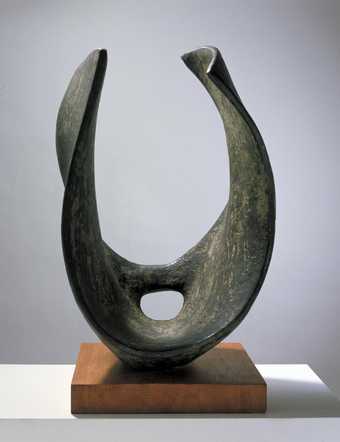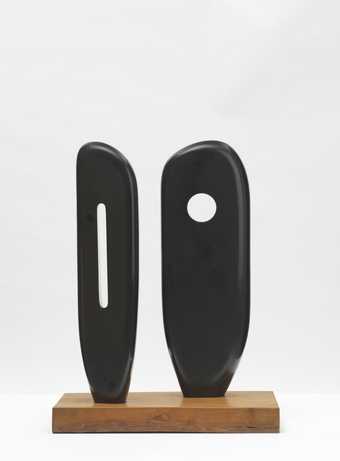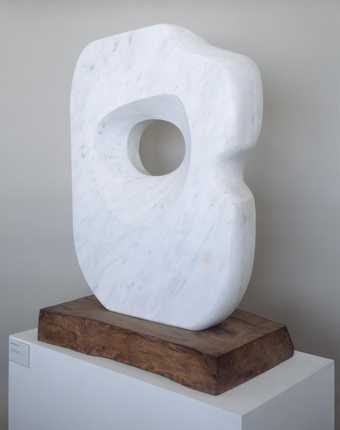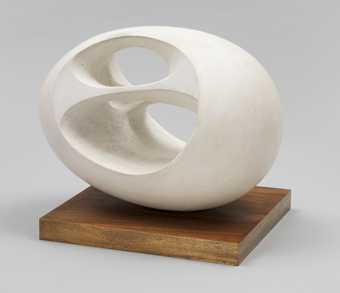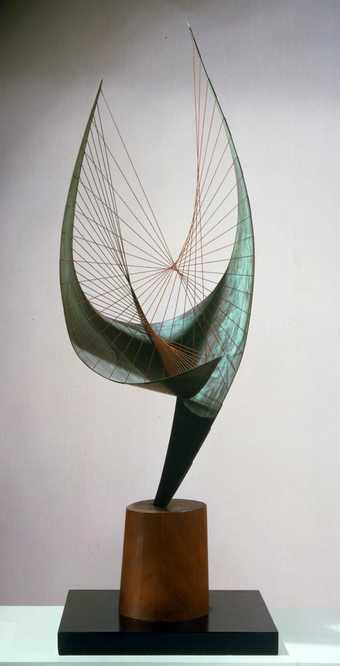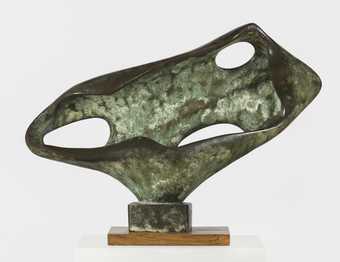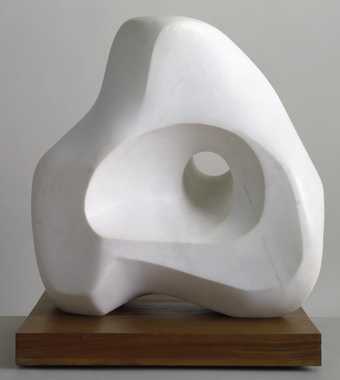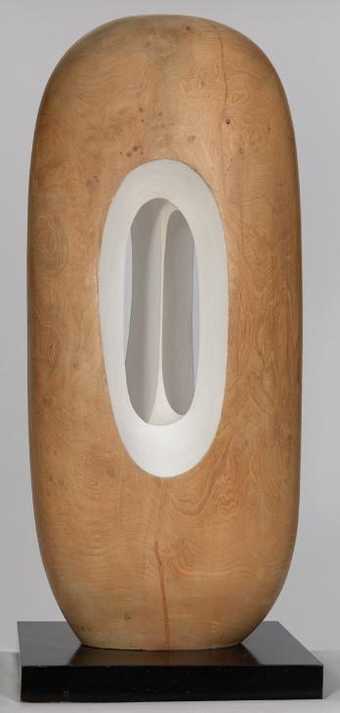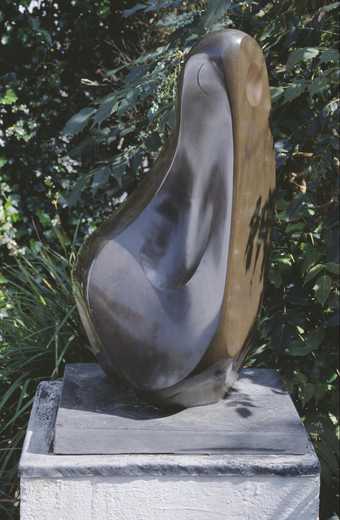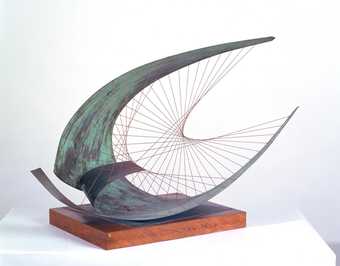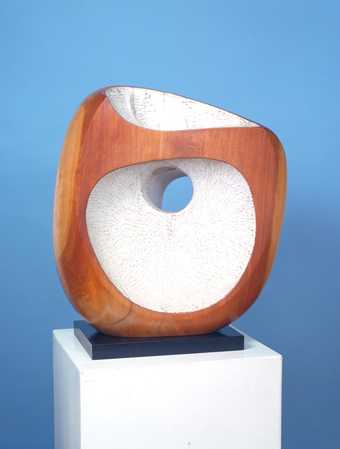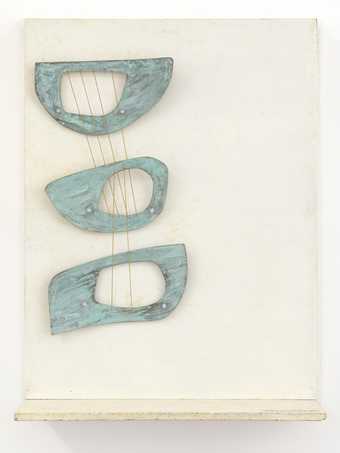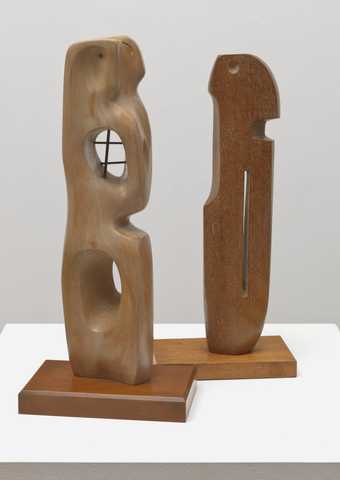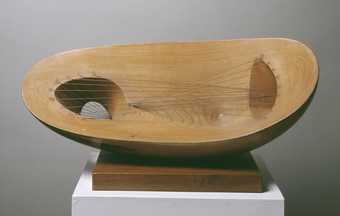Not on display
- Artist
- Dame Barbara Hepworth 1903–1975
- Medium
- Guarea wood and paint on wooden base
- Dimensions
- Object: 1041 × 1067 × 1016 mm, 410kg
- Collection
- Tate
- Acquisition
- Purchased 1962
- Reference
- T00531
Display caption
Gallery label, September 2004
Does this text contain inaccurate information or language that you feel we should improve or change? We would like to hear from you.
Catalogue entry
Dame Barbara Hepworth
1903-1975
T00531 Corinthos
1954-5
BH 198
Nigerian guarea, partially painted, 1040 x 1067 x 1015 (41 x 42 x 40) on a painted wooden base 70 x 655 x 560 (2 3/4 x 25 3/4 x 22) Weight: 410 kg
Purchased from the artist through the Whitechapel Art Gallery (Grant-in-Aid) 1962
Exhibited:
Summer Exhibition, Penwith Society of Arts, St Ives, 1955 (97)
The Seasons, CAS, Tate Gallery, March-April 1956 (54, as Corinthos (The Seasons))
Modern Sculpture, Leeds City Art Gallery, Oct.-Nov. 1958 (27)
Barbara Hepworth: An Exhibition of Sculpture from 1952-1962, Whitechapel Art Gallery, May-June 1962 (8, repr.)
Arte d'oggi nei musei, 32nd Venice Biennale, June-Oct. 1964 (London, Tate Gallery 18)
Barbara Hepworth, Tate Gallery, April-May 1968 (69)
St Ives: Twenty Five Years of Painting, Sculpture and Pottery, Tate Gallery, Feb.-March 1985 (131, repr. p.190)
Literature:
J.P. Hodin, Barbara Hepworth, Neuchâtel and London 1961, pp.21, 168 no.198, repr.
Mary Chamot, Dennis Farr and Martin Butlin, Tate Gallery: The Modern British Paintings, Drawings and Sculpture, I, 1964, pp.279-80
Robert Melville, 'Creative Gasp', New Statesman, vol.75, no.1935, 12 April 1968, p.494
David Fraser Jenkins, Barbara Hepworth: A Guide to the Tate Gallery Collection at London and St Ives, Cornwall, 1982, p.16, repr. p.29
Penelope Curtis, Modern British Sculpture from the Collection, Tate Gallery Liverpool 1988, p.53, repr.
Alan G. Wilkinson, 'Cornwall and the Sculpture of Landscape: 1939-1975' in Penelope Curtis and Alan G. Wilkinson, Barbara Hepworth: A Retrospective, exh. cat., Tate Gallery Liverpool 1994, p.98
Reproduced:
A.M. Hammacher, 1959, pls.20-1
Sir John Rothenstein, 'The Tate Gallery', Ambassador, no.11, 1962, p.53
Denis Farr, British Sculpture Since 1945, 1965, pl.2
A.M. Hammacher, Barbara Hepworth, 1968, rev. ed. 1987, p.119, pl.92
Barbara Hepworth Exhibition, 1970, exh. cat., Hakone Open-Air Museum, Japan 1970, [p.22]
Olive Whicher, Projective Geometry, 1971, p.260
Corinthos
was the first and largest of a number of sculptures, named after ancient Greek sites, that Barbara Hepworth carved from scented guarea between 1954 and 1956. Though acknowledged as one of her major works, its exhibition history has been relatively restricted by its size. Its scale is especially remarkable for a work carved from a single piece of wood, described by the artist as 'the very largest tree trunk that I have ever been able to procure from anywhere, really monumental in size' (letter to the Tate Gallery, 19 July 1962).
The sculpture was carved from guarea, a tropical hardwood. Her friend Margaret Gardiner had family connections with Africa and, when Hepworth accepted the offer of a sample, arranged for a Nigerian plantation owner to send a single tree trunk. On returning from her Greek holiday in August 1954, Hepworth received a message that 17 tons of wood had arrived from Nigeria at Tilbury docks. A tortuous process of transportation to Cornwall and man-handling through the narrow streets of St Ives followed and the butt was cut into logs ranging in size from 3/4 to 2 tons, which were stored in various locations around the town (Barbara Hepworth: A Pictorial Autobiography, 1970, New ed. 1978, p.73). Though the timber is said to have been a gift, Hepworth's comment to Ben Nicholson in October 1954 that she had 'tied up £250 in this new wood from Nigeria' suggests that she had to pay something for it (letter to Ben Nicholson, nd [shortly before 26 Oct. 1954] TGA 8717.1.1.347). In contrast to the scarcity of non-indigenous stones and woods since the beginning of the Second World War, this consignment not only enabled Hepworth to produce a series of dramatic large works, but also to lay some wood by to be worked on later. Pierced Form (Epidauros), 1960 (Tate Gallery T03141) is the product of this later campaign of work. According to Alan Bowness's catalogue raisonné of her work, she produced seven guarea pieces in 1954-6 and six between 1960 and 1963, of which one was unfinished; she was able to give wood to several of her assistants - works in guarea appear in a number of their catalogues - and there was a large amount left over. The guarea was especially welcome as, in both stone and wood, Hepworth preferred her materials to be hard. It was, she later enthused, the 'most beautiful, hard, lovely warm timber ... I was never happier' (A Pictorial Autobiography, p.73).
When acquired by the Tate, the sculpture was found to have 'countless' splits and cracks. The majority were very fine and in a concentric crazing pattern around the heart of the wood and the larger ones had been filled with guarea splints and coloured. Dicon Nance, Hepworth's former assistant, has said that the hollowing out of the timber in works such as Corinthos
helps it to dry evenly and so reduce splitting (interview with the author, 12 Oct. 1996), which may explain the concentration of the cracks around the heart of the wood at the ends; there are no splits on the outermost surfaces. In 1964 Corinthos
was taken off display because it appeared to be splitting further in the dry atmosphere of the gallery. In February of that year she told the Tate's director, Norman Reid, that she had set aside some guarea in case these 'shakes' should change while the sculpture was on display in Venice. The wood was originally polished by hand and then with 'White Silica Polish and nothing else' (ibid.), though it was noted in 1964 that the polish had acquired a matt appearance and deteriorated (Tate Gallery conservation files). The wood is a lighter colour towards the top where it has been bleached by the light. Hepworth originally painted the interior with 'Ripolin Flat' - a household paint which she used for many years - but she added 'Dulux Flat' at the time of her 1962 retrospective (letter to Norman Reid, 10 Jan. 1964, Tate Gallery conservation files). In 1986 this paint was found to be yellowing.
The size and weight of the sculpture make it especially susceptible to damage. In 1964 it sustained three bruises on its way to Venice, each about 2 x 1/4 inches (51 x 6 mm). Hepworth advised the Tate:
I have found the most successful way of dealing with [bruises] is by the use of a steamiron. I have a small Murphy iron and as soon as the steam is ready I hold it just above the surface of the bruise and the moisture percolates the wood and pulls the fibres up.
This treatment does, of course, leave a slight roughness afterwards which has to be delicately smoothed down with the finest emery; 00 or flour.
(letter to Norman Reid, 7 Jan. 1965, Tate Gallery Conservation files)
When Dicon Nance carried out this treatment in March 1965, the artist reassured the gallery that the resultant area of paler wood would tone down with time (letter to Norman Reid, 19 March 1965), though the restoration was not considered fully satisfactory. In October 1992 an accident in the Tate Gallery store involving a large steel sculpture caused six gouges, between 60 and 90 mm (2 3/8 - 3 1/2 ins) long, 5 mm (3/8 in) wide and 3-4 mm (1/4 in) deep, in one side of Corinthos. These were filled and a smooth finish was achieved by the application of a combination of waxes which could be easily burnished. This mixture was layered with wood dyes of differing tones to match the variations of colour across the surface of the sculpture. At the same time the most obvious earlier fills, which, having caused some compression damage, were now breaking up and had become lighter than the wood, were removed and similarly treated.
Corinthos
was probably begun at the very end of 1954 or beginning of 1955: Hepworth told A.M. Hammacher in February 1955 that the first guarea piece was 'taking shape', but she had made no mention of it in her letters of the preceding months to Herbert Read, either in a letter discussing her holiday in Greece, or when she sent him a photograph of her Madonna and Child
(letters to Herbert Read, 10 Oct. and 21 Dec. 1954, Sir Herbert Read Archive, University of Victoria B.C.). Though she had first employed Greek words in her titles in the 1940s with works such as Pelagos
(Tate Gallery T00699), Corinthos
is the first of a series of sculptures named after ancient Greek sites. Her friend Margaret Gardiner had taken Hepworth - exhausted after the trauma of her son's death the year before and the preparations for her Whitechapel retrospective - on a Greek cruise in August 1954. They visited several places on the mainland, including Athens and Delphi, and a number of the Aegean islands, such as Crete, Patmos and Santorin. Hepworth told the Tate Gallery that Corinthos
was, 'carved immediately on my return from Greece 1954-5. I think it summarised my experience there' (letter dated 19 July 1962, Tate Gallery cataloguing files).
The relationship between the work and Hepworth's experience of Greece, and Corinth in particular, is unclear. One might relate the sculpture to the topography around the city and Bryan Robertson has asserted that it's tunnelled form 'embodies a memory of sailing through the Corinth canal and entering the Greek world for the first time' (Barbara Hepworth: An Exhibition of Sculpture 1952-62, exh. cat., Whitechapel Art Gallery 1962, unpag.). Hepworth and Ben Nicholson had been fascinated with Greece for many years and early works, such as Single Form
(Tate Gallery T00697), had been discussed in classical terms. Though Nicholson first visited the country a few years after Hepworth, he had previously given Greek titles to his paintings and his 1954, May (Delos)
(Private collection on loan to Whitworth Art Gallery, Manchester, repr. in col., Norbert Lynton, Ben Nicholson, 1993, p.269) was in her collection. She was conscious of their association with Greece and wrote to him from Athens, 'I wish you were here. It just seems wrong to see it without you, for everytime I look I think of the way you would see it' ([Aug. 1954], TGA 8717.1.1.345).
Hepworth's description and memoirs of her trip suggest that she was drawn both to the historical and cultural associations of Greece and to her own sensuous experience of the Greek landscape. The cruise included a series of scholarly lectures on ancient Greece and the sites to be visited. The artist published a selection of the notes in her Greek sketchbook and, though there is no specific discussion of Corinth, much of her attention was devoted to the colours, forms and sensations of the places she visited ('Greek Diary 1954-1964', Walter Kern, ed., J.P. Hodin: European Critic, 1965, pp.19-24). This sensuous dimension may help to explain why she carved works with Greek associations from a Nigerian hardwood rather than the quintessentially classical marble; the original of Coré, 1955 (Tate Gallery T03135) represents an isolated attempt to unite marble and her Greek experience. Hammacher has noted Hepworth's sensual response to the guarea: he recalled that, in addition to her description of it as 'beautiful, hard ... warm', she told him that the smell of the wood was 'overpowering' at first, though it became 'more gentle and amenable' (Hammacher 1968, pp.115-17). Presumably echoing the artist, he went on to describe the guarea pieces as, 'these almost animal wood sculptures with their sonorous boom' and quoted Hepworth as saying, 'Sculpture, to me, is primitive, religious, passionate, and magical - always, always affirmative'.
In her references to the places she visited in Greece there is a recurrent religious or spiritual theme; she was especially moved by Delphi, where, she said, she found physical and spiritual ease ('Greek Diary', p.24). It may also be significant that all of the places recorded by sculptures are noted for their ancient theatres; in a later publication, Hepworth accompanied her description of her trip with photographs of three different theatres (Alan Bowness, Barbara Hepworth: Drawings from a Sculptor's Landscape, 1966, p.12). Greek theatre had featured in her work previously: Read had compared the nurses in her hospital drawings to a Greek chorus ('Barbara Hepworth: A New Phase', Listener, vol.39, no.1002, 8 April 1948, p.592) and in 1951 she had designed a production of Sophocles's Electra. In her commentary on the inspiration of Greece, Hepworth's description of watching people respond bodily to the ancient architecture in a landscape setting suggests a comparison between the form of the theatre and her conception of the figure enwrapped in the landscape (Bowness 1966, p.12). She had sought to capture this experience of landscape in the 1940s with works such as Pelagos
(Tate Gallery T00699), so that the return to abstract wood carving and the use of a painted interior in Corinthos
may be seen as a refrain of that moment.
Though a sense of this enfoldment is demonstrated in other guarea works, such as Curved Form (Delphi), 1955 (BH 199, Ulster Museum, Belfast), Corinthos
is perhaps the apogee of Hepworth's fascination with the hollowed out form and the resultant tension between interior and exterior. It is remarkable for the contrast between the two, the almost complete outer surface giving little clue to the expansive white internal space made up of a double spiral movement through the wood (detail, comparative illustration). The artist warned the Tate Gallery that photography was problematic: 'It is a very difficult one to do well, due to the relation of inside and outside carving, i.e. if you get all the outside, you hardly see the inside' (letter, 19 July 1962, Tate Gallery catalogue files). The painting of the interior dramatises the effect of the light falling through the sculpture. David Lewis had earlier held up the articulation of space by the passage of light through her sculpture as the feature which distinguished it from the work of Henry Moore ('The Sculpture of Barbara Hepworth', Eidos, 2, Sept.-Oct. 1950, p.28). As she worked on the carving, the artist was conscious of this effect; in February 1955, she wrote to Hammacher, presumably about Corinthos: 'one of the logs is taking shape - a great cave is appearing within it and I have tunnelled right through the 48 inches and daylight gleams within it. It is terribly exciting to have such enormous breadth and depth. When I have finished perhaps I shall be able to get inside it' (Hammacher 1968, p.115).
Her statement is reminiscent of interpretations that have been made of her earlier work. It has been suggested that, 'pieces such as Pelagos, 1946 [may be] read for their allusions to the womb and to the caring, sheltering function of the mother' and, as such, may be seen as embodying a positive feminine syntax (Claire Doherty, 'Re-reading the Work of Barbara Hepworth in the Light of debates on "the Feminine"' in David Thistlewood (ed.), Barbara Hepworth Reconsidered, 1996, p.168). Doherty's suggestion implies the influence, which others have identified in Hepworth's work, of Melanie Klein's theory of art as an act of reparation for attacks on the mother's womb in infantile fantasy. As with Pelagos, one may see a parallel between that psychoanalytic reading of the work in terms of the body and Hepworth's attitude to the figure enwrapped by the landscape. That the internal space of Corinthos
is to be entered by the eye is apparent from the artist's technique; the viewer is drawn in by the gradual transition from the smooth wooden exterior to the contrasting white-painted chiselled surface of the internal space. The articulation of form through this contrast of colour and texture is a characteristic of almost all of the guarea pieces and may be seen as reflecting Hepworth's interest in a Jungian dualism. In particular, her concept of the masculine and feminine as distinct but complementary traits seems to have been informed by Jung's 'animus' and 'anima' archetypes, which represented the feminine qualities in a man and masculine side of a woman. That she associated this concept with the interior and exteriors of sculptural forms is demonstrated by her Curved Form with Inner Form (Anima), 1959 (BH 265, Rijksmuseum Kröller-Müller, Otterlo, repr. Hammacher 1968, p.136).
Quoting the artist, Edwin Mullins has seen in these 'post-Greece landscapes' the first expression of 'a humanist philosophy', which Hepworth had arrived at during her Greek trip. Her comments suggest that various aspects of her experience of Greece contributed to an elevation of mankind: 'In Greece I noticed the wonderful stance of man. I thought of Greek philosophy, of the majesty of Greek tragedy, and of a certain strength of the human mind which causes people to become bigger when you see them' (Barbara Hepworth, exh. cat., Hakone Open-Air Museum 1970, unpag.). In this the guarea carvings may be seen to represent the highpoint of Hepworth's development of a humanist sculpture in which the figure in the landscape was conceived in terms of a continuous, enfolding form. Later, the motif would be seen increasingly in terms of figures located in a landscape, as exemplified by The Family of Man. Greece, the artist said, 'was a confirmation, not a transformation' (ibid.).
Chris Stephens
March 1998
Explore
- abstraction(8,615)
-
- from recognisable sources(3,634)
- non-representational(6,161)
-
- irregular forms(2,007)
- cities, towns, villages (non-UK)(13,323)
-
- Corinth(6)
- Greece(85)
You might like
-
Dame Barbara Hepworth Curved Form (Trevalgan)
1956 -
Dame Barbara Hepworth Two Figures (Menhirs)
1964 -
Dame Barbara Hepworth Pierced Form
1963–4 -
Dame Barbara Hepworth Oval Sculpture (No. 2)
1943, cast 1958 -
Dame Barbara Hepworth Orpheus (Maquette 2) (Version II)
1956, edition 1959 -
Dame Barbara Hepworth Sea Form (Porthmeor)
1958 -
Dame Barbara Hepworth Image II
1960 -
Dame Barbara Hepworth Hollow Form with White
1965 -
Dame Barbara Hepworth Coré
1955–6, cast 1960 -
Dame Barbara Hepworth Stringed Figure (Curlew), Version II
1956, edition 1959 -
Dame Barbara Hepworth Torso II (Torcello)
1958 -
Dame Barbara Hepworth Pierced Form (Epidauros)
1960 -
Dame Barbara Hepworth Maquette, Three Forms in Echelon
1961 -
Dame Barbara Hepworth Maquette for ‘The Unknown Political Prisoner’
1952 -
Dame Barbara Hepworth Landscape Sculpture
1944


